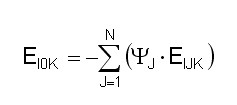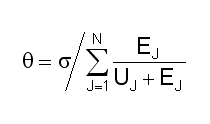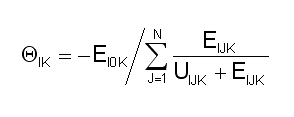As discussed in connection with Value's Measure, every SFEcon model transacts a zeroth commodity through a
zeroth sector. Good J=0 constitutes an artificial financial
unit that we have labeled ‘the global currency unit’ GCU, or G. The
GCU is a constant value unit insofar as its quantity is always fixed at whatever level it is given
at the inception of emulation; and
its turnover fraction V0 is always set at 1/year in recognition of its
meaning to the financial computations it supports.
At stasis, sector IK’s flow of value EI0K G/yr will equal the
combined value of its asset flows EIJK units/year ...

where an asset J’s absolute unit value is given
by YJ G/unit. The
sum of all EI0K over I and K must always equal
value’s constant output rate Y00 G/yr
Keeping EI0K current is accomplished by operation of Model 0’s regular circuit of physical flows. This operation presumes knowledge of: 1) P0K, the price of one GCU in terms of the currency of an economy K; and 2) asset values YJ. In this article we will continue our presumption that P0K is known (it will be determined anon) and proceed here to a express a commodity J's absolute marginal value through the familiar notion of a demand schedule.
We begin with an awareness of IK’s turnover of value EI0K as known in the manner
any asset’s turnover rate EIJK, viz.: VJ times IK’s stock of J.
EI0K’s significance lies in its value equivalence G/year to a
sector IK’s budget constraint sIK $/year of monies to be expended for asset replenishment:

An estimate of what IK needs to expend in order to approach optimality is critical to the analysis because s is the basis of one of our approaches q to an economic sector's financial discriminant z:
 Eqa. 7-5
Eqa. 7-5
If this equation is to be useful in calculating a global, constant-value commodity
prices YJ G/unit, then we must
require that q $/year be expressed as its equivalent
in G/year. We hereby introduce Q=q/P0K as this equivalent. As we are now at a point in the computational
cycle prior to our discovery of P0K, Q must
be computed by substituting -EI0K for s in Equation 7-5:

Our next reference is to the generic hyperbolic demand schedule:

which we note 1) requires a reference to the financial identities of the sectors I, viz.: zI, and 2) being limited to a single economy, neglects the subscript K.
Expression of a commodity J's demand schedule for the global sum of all economies K requires
attachment of the subscript K=0 to the parameters and independent
variables in the above, together with the obvious substitution
of QIK G/year for
all IK’s financial identities zIK:

Subscript 0 implies that DJ0 is the sum of DJK over all K=1…M and that UIJ0 is the sum of UIJK over all K=1…M. (The second of these sums further implies that the global production function for a sector I can be created by merely adding the production parameters for each J of sector I across all economies K=1…M. Our justification for this procedure is the obvious continuation of an earlier discussion on the peculiar nature of hyperbolic indifference surfaces.)
Construction of J’s global demand schedule is completed by summing the financial
discriminants zIK of the sectors I over
all economies K. This process is deterred by a consideration that
the zIK’s occur in the differing
(and varying) financial units of the respective economies
K, e.g.: $/year, €/year, £/year, ¥/year, etc. Of course the intention all along has
been to substitute QIK G/year for all IK’s financial
identities zIK — which necessitates
the ultimately desired end that PJ0 must be interpreted as YJ G/unit. It only remains to note that our procedure
for creating a global demand function out of national demand functions continues the application of
our ratio/sum technique.